- Despite no racing today, a mouthwatering scenario for the final day in Jeri
- Equipment development keeps on moving, but not always the way you’d expect
- Board sizes are going up
- Wings are getting more sophisticated
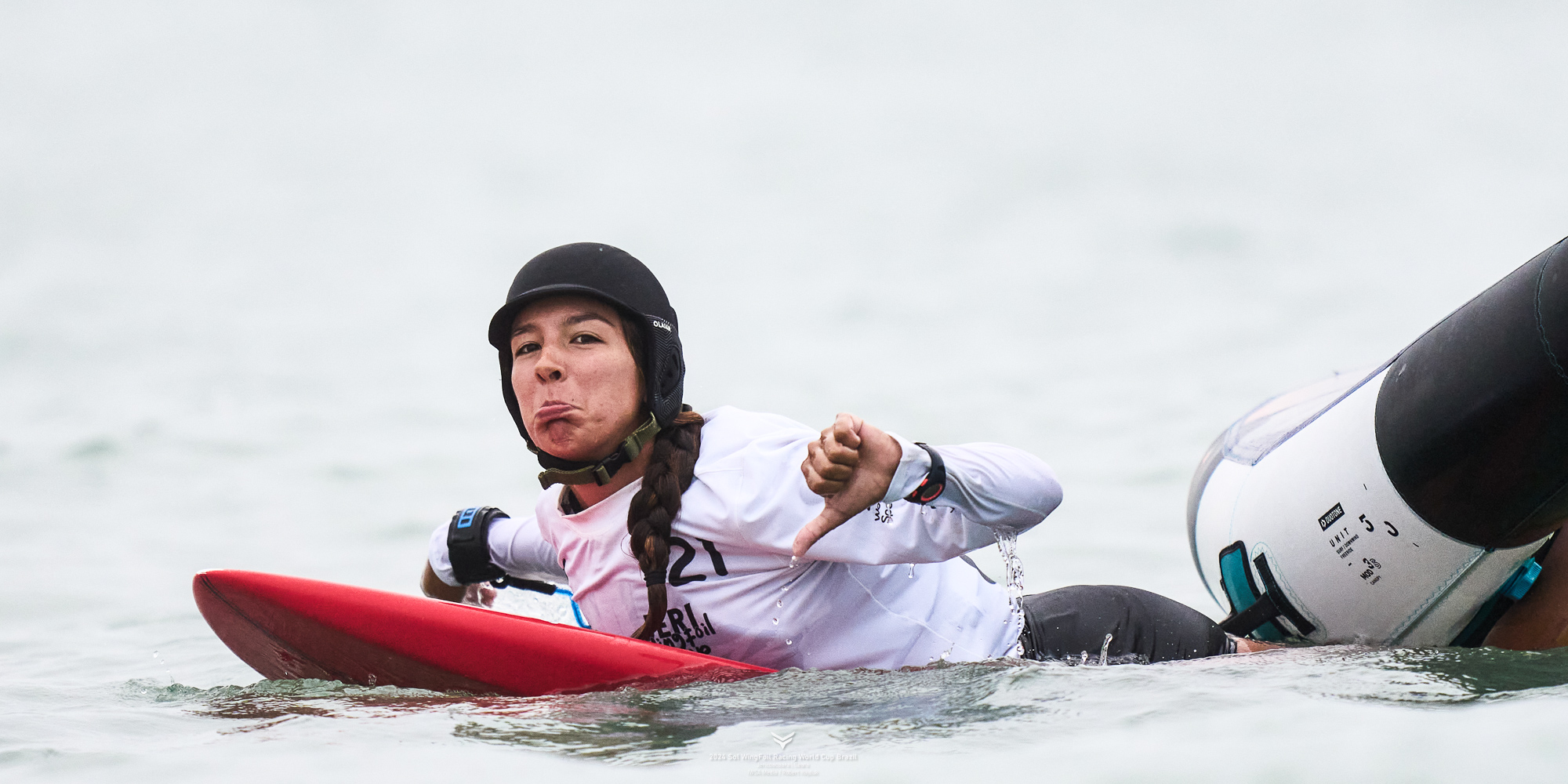
© IWSA media/ Robert Hajduk: Brazilian rider Felicitas Ceballos looking unimpressed with lack of wind
One of the trends in equipment in the past year has been for board sizes to increase. On day four of Wingfoil Racing World Cup Brazil we saw part of the reason why. Famed for its reliable breeze, Jericoacoara was unfortunately unable to deliver enough puff for the men’s and women’s fleets to get racing.
If wingfoil racing is to fulfil its destiny as a future discipline in Olympic sailing competition, the riders are going to have to be able to compete in six to seven knots of wind. Increasingly the expectation on the Wingfoil Racing World Cup circuit is to go racing in marginal foiling conditions. One of the ways of promoting earlier foiling is to go for a higher volume board.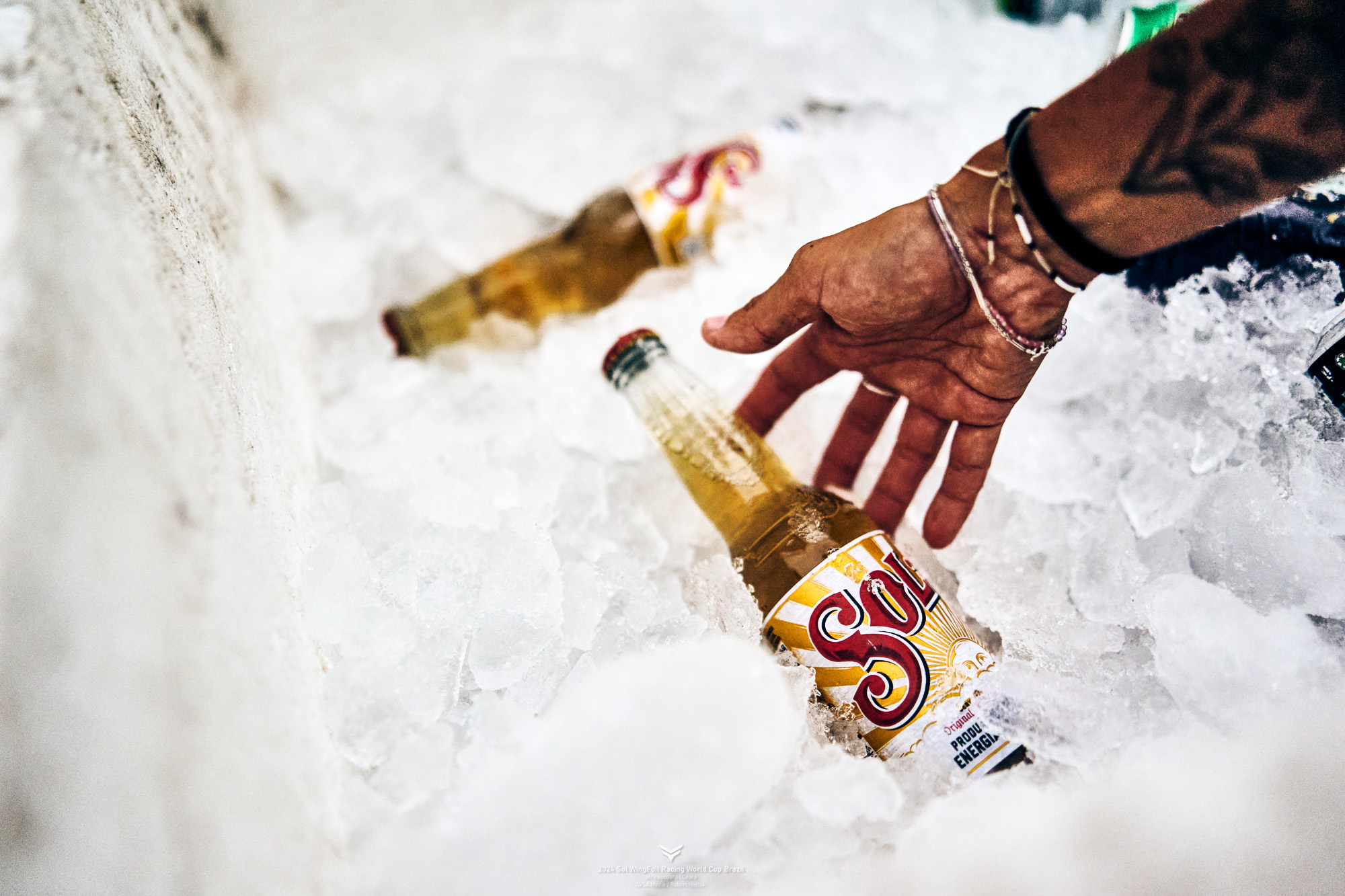
© IWSA media/ Robert Hajduk: One way to cheer up when the sun fails to shine
BOARD SIZE - BIGGER IS BETTER
Bastien Escofet, currently lying in fourth place overall in the men’s fleet, explains his own thoughts on board size. “I am using a 5’3 Gong Racer board, so it’s quite long,” says the French professional who is one of Gong’s team riders. “It’s an 80-litre board and I’m 77kg, so just a little more volume than my weight. I don't understand exactly the science behind it, but I like the length of the board because it creates more stability through the air. I thought it would have been the opposite, because as we bank the board to windward you’d think the wind would push the nose down, but it’s actually more stable.”
With the expectation that in 2025 the fleet might attempt to race in lighter conditions, Escofet believes that he might even use the 5’6 Gong Race board in softer breeze. This 95-litre board is the one currently being used by fellow team rider from Italy, Francesco Cappuzzo, who weighs more than Escofet.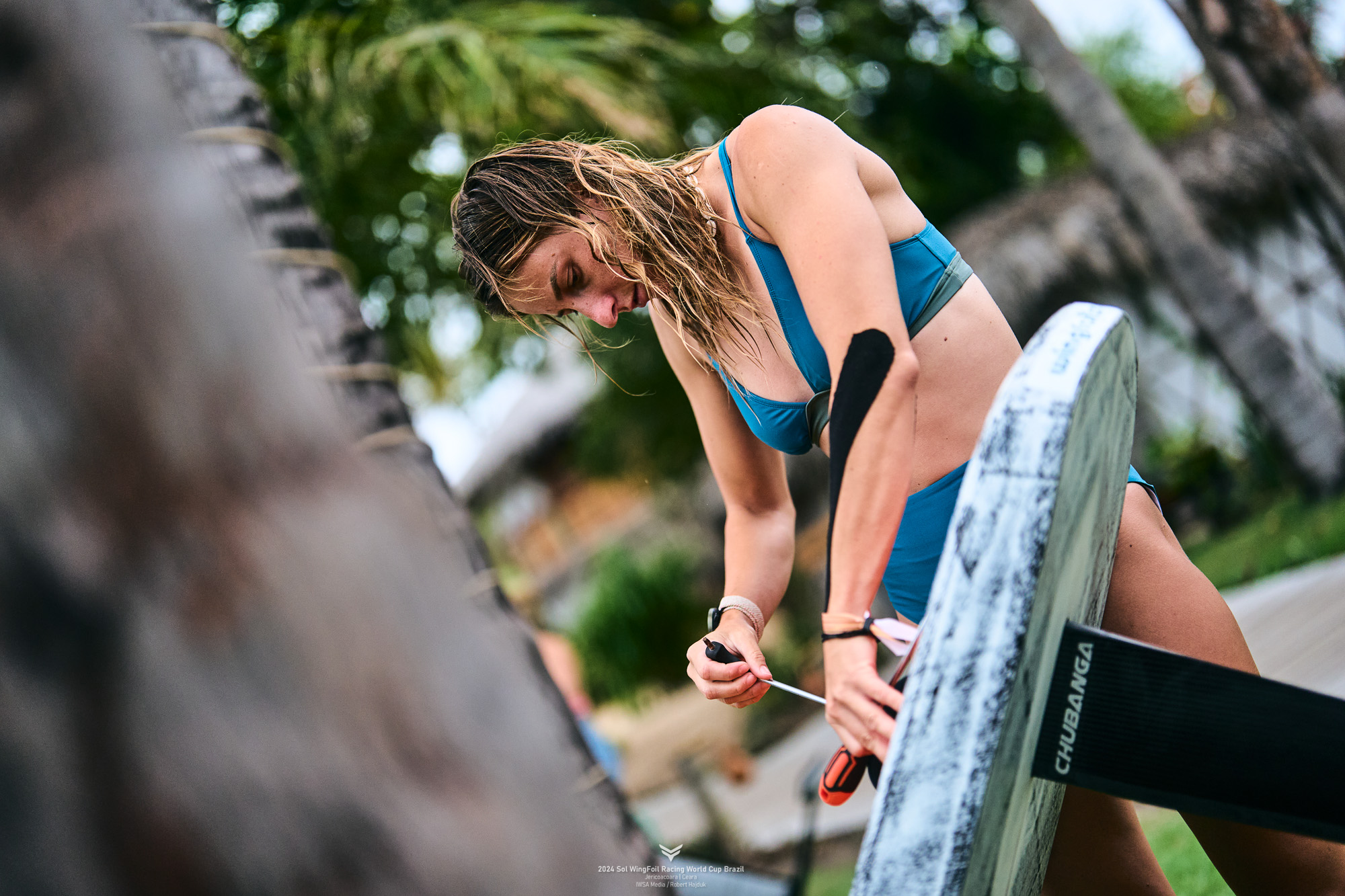
© IWSA media/ Robert Hajduk: Karolina Kluszczynska tweaking her equipment
NOT GOING BACK TO SMALL
Where Escofet uses a 5’3 board (160 cm), top women’s rider from Poland, Karolina Kluszczynska uses a 140cm board, custom made by Puls from Poland, with 60 litres of volume. “I weigh around 60 to 63kg, so my board is slightly less than my weight but it seems to work fine for me,” says the Polish rider, who also coaches on iQFOiL windsurfing circuit. “It feels comfortable in the light wind and the strong wind, and I don’t have too much of a struggle to get on the foil in the lighter wind compared with the smaller boards.”
A season or so ago, some riders were racing with boards as small as 35 litters, but Escofet says he’s never going back to tiny sizes. “I used to freestyle on 35 litres but, wow, I would never ride anything like that now,” he laughs. “Sometimes I have to ride on my teammate’s board. It’s a 55 litre and I hate it. Now when I’m freestyling I’m on a 65 litre and next year I’m thinking of switching to a 72.”
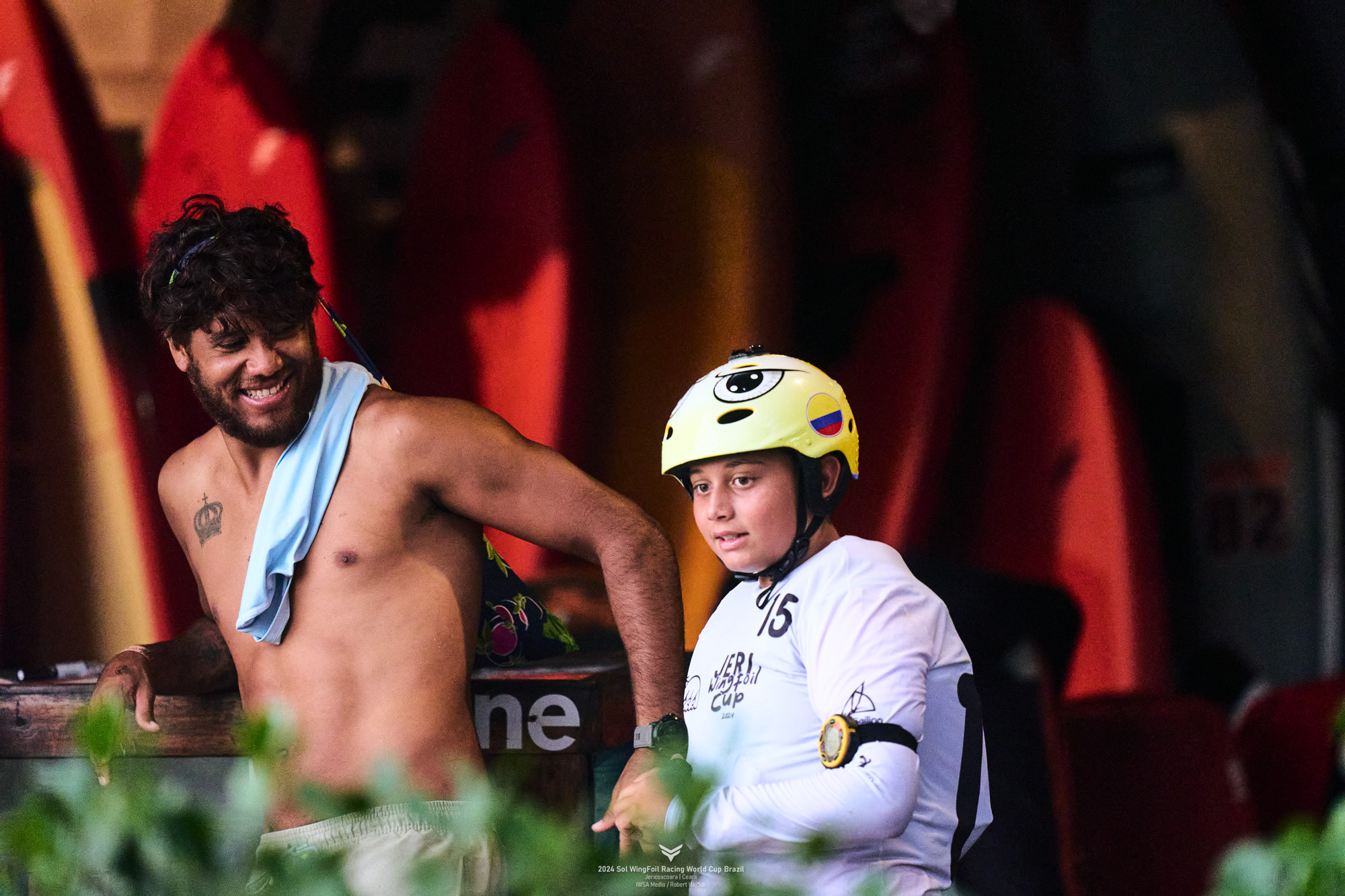
© IWSA media/ Robert Hajduk: Golden Ticket hero Gollito (left) shares a fun moment with Jean Paul Villegas
MAST LENGTH
For mast length, Kluszczynska is running a 107cm Chubanga. “It’s the same one I’ve been using for more than a year and I’m quite happy with it,” she says. Escofet on the other hand is using a 109cm Gong mast and expects to switch next season to a 112cm.
FOIL SET-UP
Kluszczynska has been using the same Chubanga foil set-up for a while and she doesn’t anticipate changing any time soon. “I think it’s 550 square cm on the front and maybe 180 on the tail. Don’t ask me about exact fuselage length but I think 60cm.”
Being the team rider that he is, Escofet is always very aware of the gear that he’s riding as he has to feed back performance and data to the Gong team on a regular basis. “I’m using 540 on the front, same as Francesco, with 180 on the back. The fuselage is about 60 to 61cm, shorter than we have had in past seasons.”
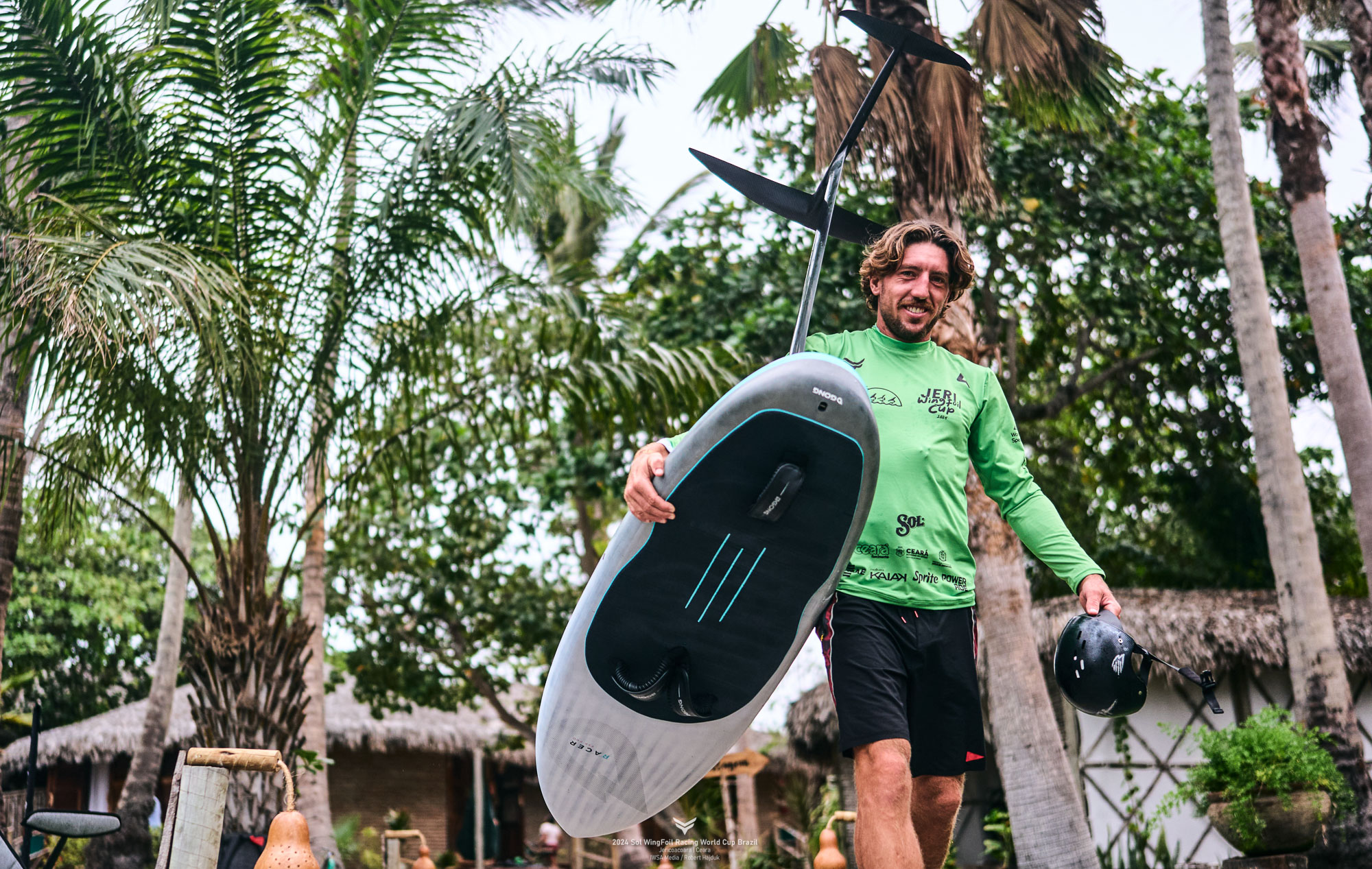
© IWSA media/ Robert Hajduk: Bastien Escofet with his Gong board
FUSELAGE LENGTH: SPEED V STABILITY
Escofet explains the trade-offs between longer and shorter fuselage lengths: “The fuselage creates a lot of drag, so the shorter fuselage means less drag and more speed, but you lose stability. A longer fuselage is better for controlling pitch and yaw [the up-and-down and side-to-side movements] through the water. So we have a small winglet on either side of the tail fin which gives you more directional stability.
“We also have a lot of dihedral shape on the front wing which provides more stability compared with a flat shape. On the first version of the foil we didn’t have enough tail fin angle so it was fast, but at a certain speed it was unstable. So we added more size to the tail fin, which also meant we had to move the mast 3cm further back to bring it back into balance.”
WHERE ARE WINGS GOING?
The past 12 months have seen the arrival of double-skin wings, otherwise known as double-profile wings. Gong were one of the early brands to pioneer this development with a semi-double-profile wing which immediately demonstrated better speed and better pointing angle on the upwind legs.
This season the top two riders in the men’s fleet - Mathis Ghio (FRA) and Kamil Manowiecki (POL) have both enjoyed good success with full double-profile wings made by Ozone. However, a new rule is likely to come in for the 2025 season that mandates a see-through window to minimise the enormous blind spot and reduce the likelihood of collisions caused by lack of visibility.
The new window rule will present a design challenge for brands building the full double-skin wings. On the other hand, some of the the semi-double-profile wings are already fitted with windows so for them it will be business as usual.
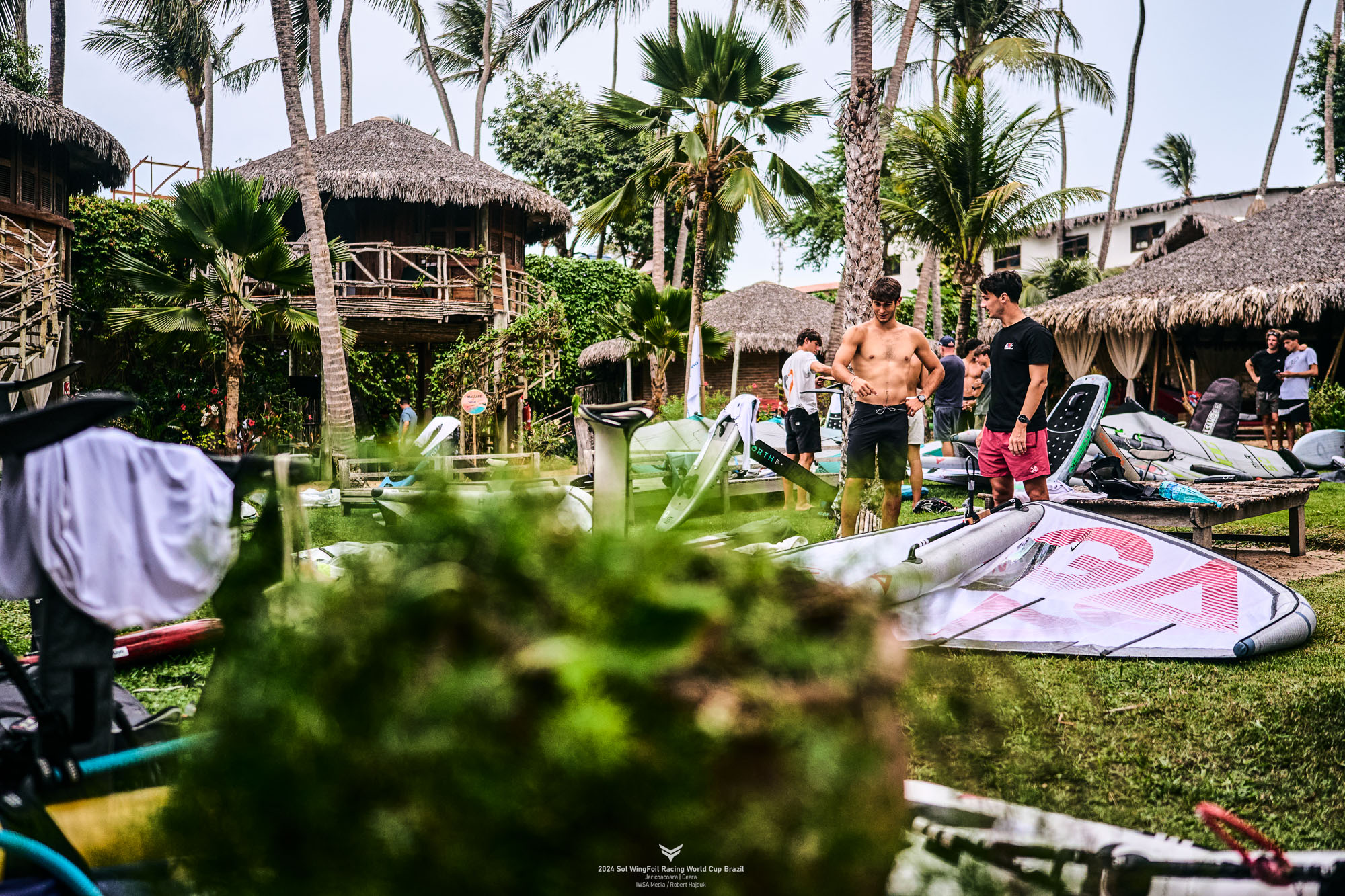
© IWSA media/ Robert Hajduk: Looking forward to a final day showdown in Jeri
GETTING STIFFER
Even though the Ozones have been quite dominant on the men’s circuit in 2024, Escofet claims his semi-double-profile Gong wing gives him good upwind efficiency while providing more feedback and ease of handling. “Francesco and I are trialling the prototypes which will go into production for next season,” says Escofet. “We have introduced battens which create a lot of rigidity right across the canopy. The battens also enable us to ‘cut off’ the corners of the wing which means less drag [through the water] and we’re reducing the thickness of the tube towards the outer ends.
“I prefer the semi-double-profile because it’s good for starting and better for tacks and gybes [compared with full double-profile]. It feels really powerful and I like this design because you can ‘feel’ the wind more and it’s a bit easier to use downwind.”
Escofet has access to multiple wing sizes ranging from 3.5 square metres through to 6.5 square metres. “If I was forced to only use two wings, for sure it would be the 5.0 and the 6.0,” he says. Kluszczynska uses Zaoli wings ranging from 4.5 to 6.5 square metres. Currently she is using standard single-skin wings but not for much longer. “The next Zaolis have battens and the double skin and I’m looking forward to testing it. I hope it will bring better upwind speed because that is what I need at the moment, although I think in the women’s fleet mostly it’s our technique rather than the gear that is the most important factor. For me, working on my tacks, my gybes and my board handling is still where I can make the biggest gains.”
GOLDEN OPPORTUNITY
Meanwhile, back to this week’s racing. Saturday begins with the long distance ‘Golden Ticket’ race to see who can cross the finish line in first place. First man and first woman to cross will be presented with their Golden Ticket which gives them the 10th and last spot in the 10-rider Medal Series. From there it’s through the Semi-Finals to see who will line up in the four-rider Finals.
In the women, Nia Suardiaz (ESP) and Maddalena Spanu (ITA) are already through to the Finals as top two qualifiers. The same in the men for Kamil Manowiecki (POL) and Francesco Cappuzzo (ITA), while defending World Champion Mathis Ghio lies in third and will have to fight his way out of the Semi-Finals.
It’s an intriguing scenario, and many will be drawing inspiration from last year’s stand-out performer on the final day of Jeri 2023, when Venezuelan star, Gollito Estredo, started the day in 14th, won the Golden Ticket and ended up grabbing the bronze medal. Anyone can still win.
RESULTS MEN
|
1. |
Kamil Manowiecki |
POL |
|
2. |
Francesco Cappuzzo |
ITA |
|
3. |
Mathis Ghio |
FRA |
|
4. |
Bastien Escofet |
FRA |
|
5. |
Alessandro Jose' Tomasi |
ITA |
|
6. |
Julien Rattotti |
FRA |
|
7. |
Oscar Leclair |
FRA |
|
8. |
Romain Ghio |
FRA |
|
9. |
Nicolo Spanu |
ITA |
|
10. |
Jeremiah Mcdonald |
NZL |
RESULTS WOMEN
|
1. |
Nia Suardiaz |
ESP |
|
2. |
Maddalena Spanu |
ITA |
|
3. |
Orane Ceris |
FRA |
|
4. |
Mar De Arce Sanchez |
ESP |
|
5. |
Iset Segura |
ESP |
|
6. |
Marta Monge |
ITA |
|
7. |
Karolina Kluszczynska |
POL |
|
8. |
Bowien Van Der Linden |
NED |
|
9. |
Paloma Gutierrez |
BRA |
|
10. |
Charlotte Baruzzi |
ITA |





